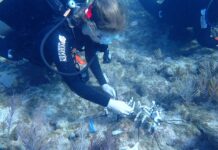
Despite heroic efforts by local dive shops and nonprofits dedicated to sea turtle rescue and rehabilitation, issues of pollution made it difficult to save “Tenora,” a green sea turtle who was rescued near Eagle Ray Alley on Molasses Reef with a large external tumor on her left shoulder. CT scans and radiographs revealed similar tumors on her lungs, and she was ultimately humanely euthanized to end her suffering.
Tenora was rescued on Saturday, during a rainy dive at the ten ball on Molasses Reef (hence her name). The rescue team was led by Rainbow Reef instructor Josh Phillips, who had made it his “personal mission” to rescue Tenora after seeing her on the reef with the softball-sized tumor for the last few months.
“I’ve dealt with a few different types of rescues but this is the best one,” Phillips said. “Turtles are one of the most amazing creatures, and I cannot even express the joy I feel right now. It’s a great day.”
Phillips had seen Tenora on his dives at Molasses Reef and engaged with the Turtle Hospital for permission to rescue her and for proper handling techniques. On their second dive of the day, he and other Rainbow Reef customers and crew successfully rescued Tenora from a ledge 30 feet underwater and brought her back to shore.
Right after the rescue, Phillips was still on a high, talking about passions and reasons for living.
“When I was underwater after the dive, it made me think that wildlife conservation is something I should look into,” he said. “This is the most amazing day of my life. It’d be life changing for anyone to be involved in an experience like this. It certainly was for me.”
Shelby Ferguson of the Turtle Hospital in Marathon was on hand and explained how green sea turtles are the species most susceptible to the virus that causes fibropapilloma (FP) tumors like the ones Tenora had.
“Green sea turtles are the ones that get the virus the most and have the tumors the most because of what they eat,” Ferguson said. “They eat a lot of seagrasses and algae, and those are the natural filters of the ocean, so they filter the pollutants. Unfortunately, the turtles eat those, which depresses their immune system, and the virus is able to take over and the tumors really explode.”
Generally, she said, the more pollution present, the more tumors the Turtle Hospital sees. Bette Zirkelbach, manager at The Turtle Hospital, explained why.
“Fibropapillomatosis is found in and around developed islands around the world in warmer climates. This tells us everything we need to know,” said Zirkelbach. “Many variables affect this disease, including water quality, temperature and life stage of the animal.”
External FP tumors are surgically removed with a CO2 laser, but there is currently no treatment for internal ones in sea turtles, Zirkelbach said. Animals like Tenora with internal masses are euthanized to minimize their suffering.
Zirkelbach warned that “sea turtles are an indicator species for our marine ecosystems” and that “what we see happening to sea turtles’ health will eventually affect all life on earth.” She urged everyone to pay attention and do better managing land and marine ecosystems to ensure that the ancient mariners do not go extinct “on our watch.”


























